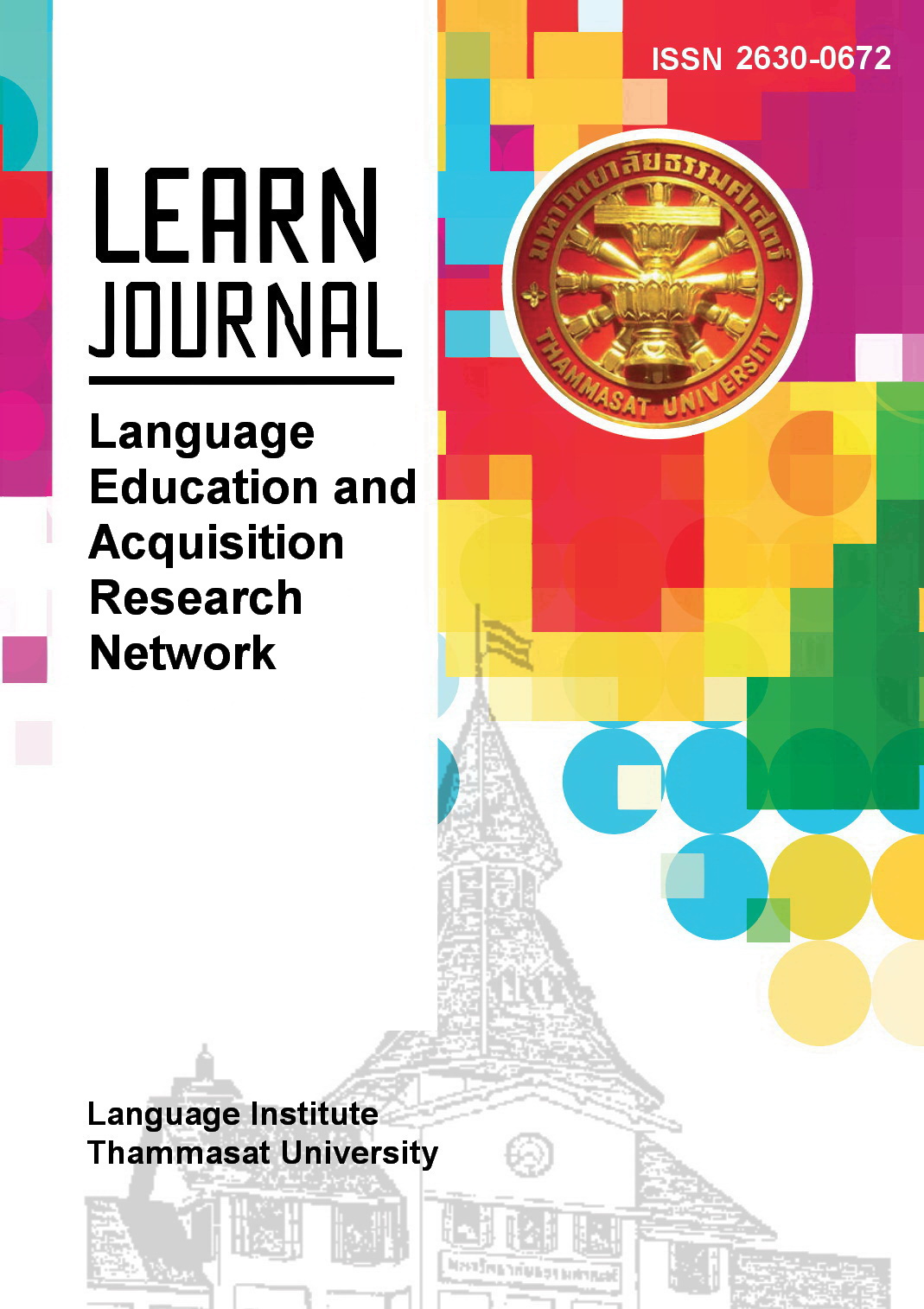Is it ‘important,’ ‘significant,’ or ‘crucial’? A Corpus Based Study of English Synonyms
Main Article Content
Abstract
Due to the large number of near-synonyms present in the English language, English learners frequently struggle to use near-synonyms in different contexts, as these words, despite similar meanings, are not always interchangeable. This study examines the distribution and collocation of three synonyms, ‘important,’ ‘significant,’ and ‘crucial,’ across genres. The objectives are to investigate differences in formality based on genre distribution and to analyze collocates in relation to semantic preference. The data from the Corpus of Contemporary American English (COCA) indicates that the synonyms are used primarily in academic contexts, with ‘important’ being the most common. Nonetheless, these synonyms differ in their collocates and themes. ‘Significant’ is frequently associated with quantity-related matters, whereas ‘crucial’ is typically associated with the political domain. ‘Important’ often appears with intensity-related adverbs, and ‘significant’ with study-related ones. Therefore, the analysis of collocates between nouns and adverbs reveals that these synonymous adjectives have both shared and distinct preferences.
Article Details
References
Alanazi, Z. (2023). A critical corpus-based analysis of the words Muslim and Islamic Vs. Christian in contemporary American English. World Journal of English Language, 13(2), 200-213.
Aroonmanakun, V. 2015. Quick or fast: A corpus-based study of English synonyms. Language Education and Acquisition Research Network (LEARN) Journal, 8(1), 53–62. https://so04.tci thaijo.org/index.php/LEARN/article/view/102685.
Bergdahl, M. (2009). Is he beautiful, handsome or good-looking? A study of putative synonymy in three adjectives [Master’s thesis, Luleå University of Technology]. http://www.diva-portal.se/smash/get/diva2:1017196/FULLTEXT01.pdf
Cai, J. (2012). Is it “great” enough? A corpus-based study of “great” and its near
synonyms [Master Thesis]. Ball State University
Carter, R. (2012). Vocabulary. Applied linguistic perspective. Routledge.
Carter, R. & McCarthy, M. (1988). Vocabulary and language teaching. Routledge.
Cheng, W. (2012). Exploring corpus linguistics. Language in action. Routledge.
Chung, S. (2011). A corpus-based analysis of “create” and “produce”. Chang Gung Journal of Humanities and Social Sciences, 4(2), 399-425.
Crystal, D. (2007). Words words words. Oxford: Oxford University Press.
Davies, M. (2020). The COCA corpus (new version released March 2020). https://www.englishcorpora.org/coca/help/coca2020_overview.pdf
Dvorak, J., Dawson, M. (2011). Crisis Management Terminological Synonyms. Safety Engineering Series, 6(2), 52-55.
Edmonds, P., & Hirst, G. (2002). Near-synonymy and lexical choice. Computational Linguistics, 28(2), 105-144. https://dx.doi.org/10.1162/089120102760173625
Folse, K. S. (2004). The underestimated importance of vocabulary in the foreign language classroom. CLEAR News, 8(2), 1-6.
http://www.seasite.niu.edu/trans/articles/Underestimated%20Importance%20of%20Vocab.htm
Gablasova, D, Brezina, V. & McEnery, T. (2017). Collocations in corpus-based language learning research: Identifying, comparing, and interpreting the evidence. Language Learning. 67(1), 155-179.
Gardner, D. (2013). Exploring vocabulary in action. Routledge.
Gass, S. M., & Selinker, L. (2008). Second language acquisition: An introductory course (3rded.). Routledge.
Harley, H. (2006). English words: A linguistic introduction. Blackwell
Imsa-ard, P. (2021). A corpus-based study on the meanings, distribution, collocations, and formality of ‘concentrate’, ‘emphasize’, and ‘focus’. NIDA Journal of Language and Communication, 26, 22-40.
Jarunwaraphan, B., & Mallikamas, P. (2020). A corpus-based study of English synonyms: Chance and opportunity. REFLections, 27(2), 218–245. https://so05.tci-thaijo.org/index.php/reflections/article/view/248710
Laufer, B. (1997). What's in a word that makes it hard or easy? Intralexical factors affecting the difficulty of vocabulary acquisition. In N. Schmitt & M. McCarthy (Eds.), Vocabulary: Description, acquisition and pedagogy (pp. 140-155). Cambridge University Press.
Lertcharoenwanich, P. (2023). Analysis of collocations and semantic preference of the near-synonyms: Blank, empty, and vacant. LEARN Journal: Language Education and Acquisition Research Network, 16(1), 365-383. https://so04.tci-thaijo.org/index.php/LEARN/article/view/263447
Longman Dictionary of Contemporary English. (Online).
Ly, T. H. & Jung, C. K. (2015). A corpus investigation: The similarities and differences of ‘cute’, ‘pretty’ and ‘beautiful’. 3L: The Southeast Asian Journal of English Language Studies. 21(3), 125-140. http://ejournals.ukm.my/3l/article/view/8788/3426
Martynska, M. (2004). Do English language learners know collocations? Investigationes Linguisticae, 11, 1-12.
Merriam-Webster dictionary. (Online). https://www.merriam-webster.com/
Nation, I. S. P. (2013). Learning vocabulary in another language (2nd ed.). Cambridge University Press.
Nisani, F. 2015. A corpus-based study of English synonyms: Possible, probable, and likely. [Master’s thesis, Thammasat University]. http://ethesisarchive.library.tu.ac.th/thesis/2015/TU_2015_5721040417_4760_2844.pdf
Oxford advanced American dictionary. (Online).
https://www.oxfordlearnersdictionaries.com/definition/american_english/
Petcharat, N., & Phoocharoensil, S. (2017). A corpus-based study of English synonyms: Appropriate, proper, and suitable. LEARN Journal: Language Education and Acquisition Research Network, 10(2), 10–24. https://so04.tci-thaijo.org/index.php/LEARN/article/view/111700
Phoocharoensil, S. (2010). A corpus-based study of English synonyms. International Journal of Arts and Sciences. 3(10), 227 - 245.
Phoocharoensil, S. (2020). A genre and collocational analysis of consequence, result, and outcome. 3L: Language, Linguistics, Literature. The Southeast Asian Journal of English Language Studies, 26(3), 1–16.
Phoocharoensil, S. (2020a). Collocational patterns of near synonyms error, fault and mistake. The International Journal of Communication and Linguistic Studies, 19(1), 1-17. https://dx.doi.org/10.18848/2327-7882/CGP/v19i01
Phoocharoensil, S. (2020b). A genre and collocational analysis of consequence,
result, and outcome. The Southeast Asian Journal of English Language Studies, 26(3), 1 – 16. http://dx.doi.org/10.17576/3L-2020-2603-01
Phoocharoensil, S. (2022). Primary, main, and major: Learning the synonyms through corpus data. GEMA Online Journal of Language Studies, 22(4). 76–89. https://ejournal.ukm.my/gema/article/view/52706/13509
Saito, K. (2020). Multi- or single-word units? The role of collocation use in comprehensible and contextually appropriate second language speech. Language Learning, 70(2), 548–588.
Sinclair, J. (2004). Trust the text. Routledge.
Sittironnarit, S., Khunasathitchai, K., Kosashunhanan, K., & Kumdee, S. (2022). A corpus-based analysis of English synonyms: Acquire and obtain. Journal of Roi Kaensarn Academi, 7(9), 242-252.
Stubbs, M. (2001). Words and phrases: Corpus studies of lexical semantics. Blackwell Publishers.
Smyth, C. (2016). An introduction to corpus Linguistics. Journal of Art and Sciences, 14, 105–109. https://core.ac.uk/download/pdf/234563686.pdf.
Taylor, J. R. (2002). Near synonyms as co-extensive categories: ‘high’ and ‘tall’ revisited. Language Science, 25, 263-284.
Thornbury, S. (2002). How to teach vocabulary. Longman.
Wilkins, David. 1972. Linguistics in Language Teaching. Edward Arnold.
Yang, B. (2016). A corpus-based comparative study of “learn” and “acquire”. English Language Teaching, 9(1), 209-220. http://dx.doi.org/10.5539/elt.v9n1p209


